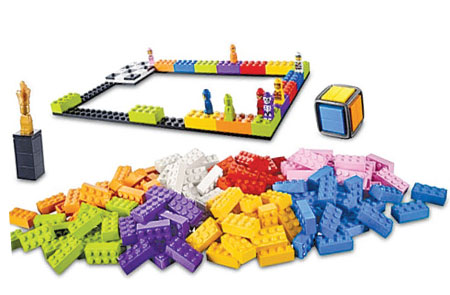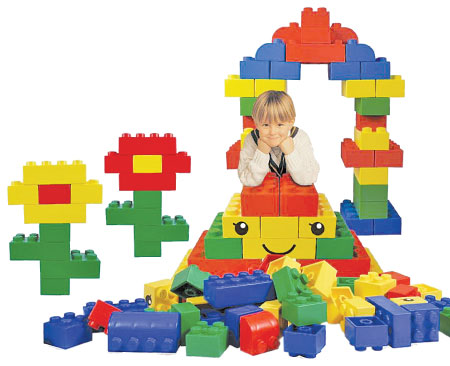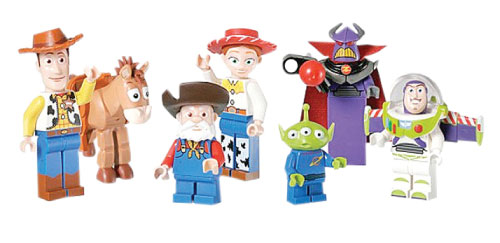Lego- a fascinating game
The name 'LEGO' is an abbreviation of the two Danish words 'leg godt',
meaning 'play well'. It's our name and it's our ideal.
 The LEGO Group was founded in 1932 by Ole Kirk Kristiansen. The
company has passed from father to son and is now owned by Kjeld Kirk
Kristiansen, a grandchild of the founder. The LEGO Group was founded in 1932 by Ole Kirk Kristiansen. The
company has passed from father to son and is now owned by Kjeld Kirk
Kristiansen, a grandchild of the founder.
It has come a long way over the past almost 80 years - from a small
carpenter's workshop to a modern, global enterprise that is now, in
terms of sales, the world's third-largest manufacturer of toys. The LEGO
brick is our most important product. This is why we are proud to have
been named twice - 'Toy of the Century'. Our products have undergone
extensive development over the years - but the foundation remains the
traditional LEGO brick.
The brick in its present form was launched in 1958. The interlocking
principle with its tubes makes it unique, and offers unlimited building
possibilities. It's just a matter of getting the imagination going - and
letting a wealth of creative ideas emerge through play.
The company that makes the famous, little, plastic, interlocking
bricks known as LEGO started as a small shop in Billund, Denmark.
Established in 1932 by master carpenter Ole Kirk Christiansen who was
aided by his 12-year-old son Godtfred Kirk Christiansen, the company
made wooden toys, stepladders, and ironing boards. It wasn't until two
years later that the business took the name of Over the next several
years, the company grew exponentially. From just a handful of employees
in the early years, LEGO had grown to 50 employees by 1948. small shop in Billund, Denmark.
Established in 1932 by master carpenter Ole Kirk Christiansen who was
aided by his 12-year-old son Godtfred Kirk Christiansen, the company
made wooden toys, stepladders, and ironing boards. It wasn't until two
years later that the business took the name of Over the next several
years, the company grew exponentially. From just a handful of employees
in the early years, LEGO had grown to 50 employees by 1948.
The product line had grown as well, with the addition of a LEGO duck,
clothes hangers, a Numskull Jack on the goat, a plastic ball for babies,
and some wooden blocks.
In 1947, the company made a huge purchase that was to transform the
company and lead it to world fame. In that year, LEGO bought a plastic
injection-molding machine, which could mass produce plastic toys. By
1949, this machine was producing about 200 different kinds of toys,
including Automatic Binding Bricks, a plastic fish, and a plastic
sailor. The Automatic Binding Bricks were the predecessor of the LEGO
toys of today.
In 1953, the Automatic Binding Bricks were renamed LEGO Bricks and in
1958, these bricks underwent a slight change in their design, which
transformed them into the LEGO Bricks we know today. Also in 1958, Ole
Kirk Christiansen passed away and his son Godtfred became head of the
LEGO company.
By the early 1960s, LEGO had gone international, with sales in
Sweden, Switzerland, United Kingdom, France, Belgium, Germany, and even
Lebanon.
Over the following decade, more countries started to sell LEGO toys,
including the United States in 1973.
In 1964, for the first time, consumers could buy LEGO sets, which
included all the parts and instructions to build a particular model.
LEGO later introduced themed lines of LEGO, including town (1978),
castle (1978), space (1979), pirates (1989), Western (1996), Star Wars
(1999), and Harry Potter (2001).
For over half a century, these small, little, plastic bricks have
sparked the imagination of children around the world and LEGO remain one
of the world's most popular toys.
Little plastic bricks which sparked the imagination of children

In 1969, a range of simple blocks which measure twice the width,
height and depth of standard Lego blocks, were aimed at younger
children.In 1978 Lego produced the first minifigures which have since
become a staple in most sets. New elements are often released along with
new sets.
There are also Lego sets designed to appeal to young girls such as
the Belville and Clikits lines which consist of small interlocking parts
that are meant to encourage creativity and arts and crafts, much like
regular Lego bricks. Belville and Clikit pieces can interlock with
regular Lego bricks as decorative elements.
Lego Fabuland ran from 1979 to1989. The more advanced Lego Technic
was launched in 1977. LegoPrimo is a line of blocks by the Lego Group
for very young children thatran between 2004 and 2006. In 1995 Lego Baby
was launched for babies.
In May 2011, Space Shuttle Endeavour brought 13 Lego kits to the
International Space Station where astronauts will build models and see
how they react in microgravity,as part of the Lego Bricks in Space
program. The results will be shared with schools as part of an
educational project. In May 2013, the largest model ever created was
displayed in New York made of over 5 million bricks; a 1:1 scale model
of an X-Wing Other records are a 112-foot tower and a 4km railway.
- Internet |

